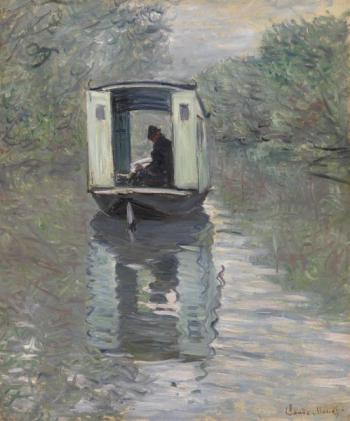Serendip is an independent site partnering with faculty at multiple colleges and universities around the world. Happy exploring!

Art Museums: Do they enlighten or isolate individuals?
Jessica Bernal
ESEM- Play in the City
Art Museums: Do they enlighten or isolate individuals?
When I was younger, I never went to museums. My mother would say, “We don’t have time for that.” The first time I ever walked into a museum, The Museum of Natural Sciences, I was about nine years old and I thought this might be what Disney World is like too, huge and overwhelming. Growing up, we didn’t have the money or the time to wander through museum’s unique collections. As I got older, I kept going to more and more different types of museums through school, but to this day, never have I been with my mother. As she’d say, Yo no le entiendo a esas cosas, I don’t understand those types of places.
It’s not that my mother doesn’t like art or find paintings interesting, it’s that she doesn’t feel comfortable in that type of environment museums provide. And unfortunately, it’s not just my mother who feels this way. Underprivileged individuals don’t find themselves pursuing Art Museums, or museums in general as a means of enjoyment and entertainment for a family weekend. Art Museums don’t cater to the underprivileged. Art museums isolate individuals in society rather than welcome them, which is the sole purpose of museums in general, to make accessible artifacts and collections to the people to explore and enjoy.

The Presentation of Art
There in never just one way to look at and understand anything. Not only does each person bring their own knowledge and experience into their view, their perspective is also shifted by the surrounding conditions. Generally people do not look for the subtle effects that the presentation of an object has on the meaning of that object. The way in which an object is presented has a strong effect on the overall meaning and purpose of that object. This is especially true when talking about art. Most people look only at the artwork itself and don’t consider the affect that its surroundings and their own prior knowledge have on how they see the art.
Albert Barnes, the creator of the Barnes Foundation, was a strong believer in the idea that the viewing experience and understanding of art is entirely reliant on the way that it is presented. As he created and grew his private art collection that later became the Barnes Foundation, he paid very close attention to the placement of each and every piece inside his house. He arranged them all in such a way as to create connections between all the different pieces in each room and on each wall. No piece was meant to be viewed alone. When the foundation was opened, Barnes used these careful arrangements to teach his students how they should look at the collection and at art in general.

Crashing the Iconoclast
In class discussion, we all seemed to consider the move of Barnes Foundation a failure, because it defied Barnes’ intention. But after reading The Believing Game which asks us to “scrutinize unfashionable or even repellent ideas for hidden virtues”, I tried to believe that the move had some positive aspects as I re-read my trip.
The minimalistic architecture itself was beautiful. The cement exterior seemed hard and indifferent, but the glass and the shallow water made everything delicate and ephemeral. Before entering the gallery, we had to walk across a large empty space and go through ticket and bag and coat checking, which made me feel unwelcomed. Feeling the expensiveness in the air, I expected the inside display to be one painting per wall, so that the artworks could be given sacred majesty and be enshrined and worshiped.
On the contrary, paintings are placed close together, so close that, in order to keep them from fighting for space, they are separated by huge keys, carved fences, and spearheads. Now that the artworks exist in peace and harmony, they talk and dance with each other. Two pieces of the same painter share similarity or symmetry; a huge portrait of an elderly man surrounded by smaller portraits of children like an old man surrounded by his grandchildren; an ancient African painting looks like a 19th century work; a painting and a sculpture have astonishingly similar patterns.

The Experience of Viewing Art
Previous to visiting The Barnes Foundation, I viewed art through the lens of “Who painted this painting? Have I heard of them? Yes? Okay, it must be good then.” I have never taken a formal art class, nor spent a lot of time researching art beyond that of museum visits and the “art masterpiece” classes that I had in elementary school. I would generally base my opinion of a painting on how “valuable” it was deemed by others, not by if I genuinely enjoyed the painting. I was stripped of this superficial way of viewing art as I wandered through The Barnes Foundation. Without the massive white walls and plaques of a traditional museum persuading me to create an opinion, I was instead able to develop my own personal value of the art based purely on my enjoyment and emotional connections to the piece. Before visiting The Barnes Foundation I had never considered how the arrangement, surroundings, and environment that a piece of artwork is placed in affects the experience of the viewer. However, after spending time in the Foundation, I realized that the environment of a piece of artwork can have an extremely powerful influence on how it is experienced.

The Barnes, Revisited
The weekend of November 25th, I visited the Barnes foundation for the first time. While there, I enjoyed the art; travelling from room to room, watching the interplay and conversations between the pieces and the objects, studying how things reflected, contrasted, or contradicted each other. I’m sure Barnes would have approved of my attempt, no matter what he thought of the situations under which I was making it. Next, I sat in front of “Scout Attacked by a Tiger”, by Henri Rousseau, for thirty minutes. This, I think, Barnes would have objected to.


The Chill
 The Chill
The Chill
I was walking along the street, my left hand laboriously holding the umbrella, my right hand checking the map in my cell phone, almost frozen in the cold wind. It was snowing heavily, which colored the city white. However, I was in no mood to enjoy the scenery of snow because when I finally arrived at the museum, I was out of energy and could not stop shivering.
Although the chill made me upset, when I went into The Barnes Foundation, I was not only surprised but also delighted—it was delicately decorated, and, the most important, warm! However, when I saw a painting on the wall (which I posted with this essay), I felt another kind of chill again, which was completely different from the chill I just suffered outside the museum. Thus, I became curious and sat down to observe it for at least half an hour.

Barnes Foundation Re-Write
When I think of graffiti, I don’t equate it with the same art I saw in the Barnes Foundation. In the eyes of the law, graffiti is a punishable offense. It is “writing or drawings that have been scribbled, scratched, or sprayed illicitly on a wall or other surface in a public place.” I believe if the word ‘illicitly’ is omitted from this definition, it would take on a whole new face. Whenever I go to a new city, I always make sure to look at the graffiti because it provides a very public window into the social, political, and economical climate of said city. It can almost be considered a form of propaganda. It is a way of communicating to the Man. There’s an excellent example of graffiti in my new favorite movie. In Catching Fire when Katniss and Peeta are on the train to the Capitol, Katniss’s mockingjay symbol flashes by as they enter a rebelling district. When the train slows, they see more graffiti vehemently declaring “The odds are never in our favor.”

The Price of Forgery
AnotherAbby and mmanzone proudly present: The Price of Forgery
Bold sections were written by AnotherAbby.
Italicized sections were written by mmanzone.
The sections were meant to be able to be read together as one or separately. Enjoy.

Lenses
 Does the lens we look at a painting through change when it is in new surroundings?
Does the lens we look at a painting through change when it is in new surroundings?
I think that the surroundings of a painting can certainly change the lens it is looked through. Think, for example, of what you would value a painting at if you saw it in a dumpster outside versus if you saw it hanging in the Louvre. But, looking specifically at the Barnes Foundation after visiting, I found myself doubting whether the surroundings had really changed as much as people were complaining about in The Art of the Steal.
Barnes would have you believe that being in the city changed the paintings a lot, and that this is why he wanted the Foundation to stay where it was originally founded. But if the immediate surroundings of the painting are the same, such as they are now in the Barnes (the walls are kept the same, with everything exactly where it was--even the rooms are the exact dimensions as they were when the Foundation was in Merion), is being in a different city really a new lens? Or is it the same lens, but with maybe slightly different background thoughts going in?

Unbinding Gender Roles and Closing the Gender Gap
Throughout this semester, as we’ve discussed several feminist issues and viewpoints, our class has been unable to define simply what feminism is. However, we’ve been able to agree several times on what feminism is not: feminism is not gender stereotypes and norms, it is not the pressure that women (and men) feel to have a certain body type and look a certain way, and it is certainly not, as we’ve discussed amongst ourselves and with Heidi Hartmann, the wage gap between men and women. Whatever feminism is, it definitely aims to abolish the above issues, but it hasn’t yet been able to do so. The gender wage gap is still very real in today’s society, even among men and women in the same profession, and even though more women than men are earning bachelor’s degrees. So what’s binding feminism? In other words, what’s preventing feminism from achieving its goals, limiting feminism, and restraining it?


